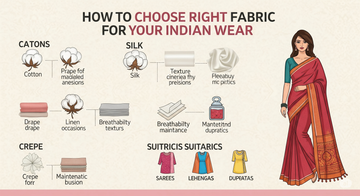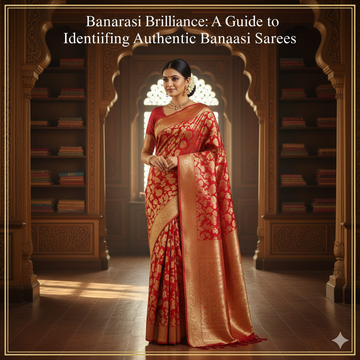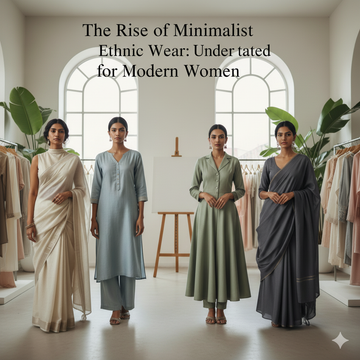
Indian fashion is a tapestry of colors, craftsmanship, and culture. Every fold of a saree, every pleat of a lehenga, and every dupatta drape tells a story that’s older than time and as vibrant as a monsoon bloom. At the heart of this elegance lies the choice of fabric. The way a garment feels against your skin, flows as you walk, or holds its shape when you twirl—it all begins with fabric. In this Indian fabric guide, we explore how to choose the right fabric for your ethnic ensembles, honoring both tradition and comfort.
Choosing the Right Fabric for Your Look
What is the cheat code of choosing the perfect fabric? It starts with asking the right questions:
● What’s the occasion?
● What’s the climate?
● How much movement or structure do you need?
If you’re looking for comfort and ease, go with cotton saree fabric. For opulence, silk fabric for Indian wear remains unbeatable. When drama is the goal, choose a rich fabric for lehenga like velvet or brocade. If you’re after something modern, try lighter fabrics like chiffon or organza. A well-rounded Indian fabric guide will always stress this—comfort, elegance, and purpose must align.
Understand the Role of Fabric in Indian Fashion
Indian ethnic wear is as diverse as the land it represents. From breezy sarees worn during sultry summers to opulent lehengas adorning festive nights, the fabric forms the very foundation. Each occasion, each silhouette, and each region brings its own flavor. So understanding fabric types isn’t just practical, it’s empowering.
Types of Indian Fabrics: A Symphony of Textures
 The types of Indian fabrics available today are rich and varied. Think of the softness of muslin, the sheer grace of chiffon, or the earthy charm of khadi. Among these, some fabrics have stood the test of time in every woman’s wardrobe.
The types of Indian fabrics available today are rich and varied. Think of the softness of muslin, the sheer grace of chiffon, or the earthy charm of khadi. Among these, some fabrics have stood the test of time in every woman’s wardrobe.
Silk, often synonymous with luxury, is perhaps the most regal among them. The sheen, the drape, and the way zari work shines on it make silk fabric for Indian wear a timeless classic. On the other hand, cotton remains the darling of daily wear and understated elegance. Especially when it comes to sarees, nothing quite matches the breathable beauty of cotton saree fabric.
Cotton: Graceful Simplicity for Everyday Elegance
 For those who seek comfort without compromising style, cotton is a sanctuary. The cotton saree fabric is known for its airy quality, making it ideal for humid climates. Whether it's a simple Chanderi cotton with delicate buttas or a bold, block-printed Bagru piece, cotton exudes grace. Pair it with a sleek blouse and fresh gajra in your hair, and you’ve captured everyday elegance.
For those who seek comfort without compromising style, cotton is a sanctuary. The cotton saree fabric is known for its airy quality, making it ideal for humid climates. Whether it's a simple Chanderi cotton with delicate buttas or a bold, block-printed Bagru piece, cotton exudes grace. Pair it with a sleek blouse and fresh gajra in your hair, and you’ve captured everyday elegance.
Cotton also responds well to daily wear and tear, making it a practical choice. That said, gentle washing and proper storage are key aspects of fabric care for ethnic wear, especially cotton, which tends to wrinkle easily.
Silk: The Eternal Empress
 From weddings to religious festivities, silk rules the scene. Banarasi, Kanchipuram, Tussar, and Bhagalpuri silks—each variety tells a tale of skilled artistry. The silk fabric for Indian wear doesn't just look grand; it feels like royalty. Its natural sheen, ability to hold embroidery, and body-enhancing drape make it a favorite for timeless events.
From weddings to religious festivities, silk rules the scene. Banarasi, Kanchipuram, Tussar, and Bhagalpuri silks—each variety tells a tale of skilled artistry. The silk fabric for Indian wear doesn't just look grand; it feels like royalty. Its natural sheen, ability to hold embroidery, and body-enhancing drape make it a favorite for timeless events.
Despite its opulence, silk needs tender care. Dry cleaning is highly recommended to preserve its intricate weaves and ensure longevity. When thinking about fabric care for ethnic wear, silk demands both respect and attention.
Chiffon & Georgette: Featherlight Glamour
 If you’re aiming for a more fluid, modern silhouette, chiffon and georgette are your go-to choices. These fabrics drape beautifully, adding an ethereal quality to sarees and suits. The types of Indian fabrics today include modern blends and synthetic variants that mimic traditional weaves—perfect for fusion looks.
If you’re aiming for a more fluid, modern silhouette, chiffon and georgette are your go-to choices. These fabrics drape beautifully, adding an ethereal quality to sarees and suits. The types of Indian fabrics today include modern blends and synthetic variants that mimic traditional weaves—perfect for fusion looks.
Because they’re delicate, these fabrics are often chosen for layered styles or paired with heavier embellishments. Gentle hand washing or light dry cleaning ensures they remain fluttery and fresh.
Velvet & Brocade: Drama, Volume, and Royalty
 For winter weddings or regal events, nothing speaks louder than velvet and brocade. These are luxurious, weighty fabrics that command attention. Whether it's a brocade blouse paired with a plain saree or a full velvet lehenga, the texture alone adds richness.
For winter weddings or regal events, nothing speaks louder than velvet and brocade. These are luxurious, weighty fabrics that command attention. Whether it's a brocade blouse paired with a plain saree or a full velvet lehenga, the texture alone adds richness.
When selecting fabric for lehenga, consider how you want it to fall—velvet adds structure, while brocade brings shimmer through woven patterns. These fabrics can transform even a simple silhouette into a show-stopper. However, they also demand specific storage and limited wash to maintain their grandeur.
Net & Organza: Contemporary Twists
 The newer entrants to Indian ethnic wear, net and organza offer a whimsical touch. These translucent fabrics are often layered or embroidered with floral motifs, sequins, or thread work. While they may not have the legacy of silk or cotton, they’ve carved a niche in contemporary ethnic design.
The newer entrants to Indian ethnic wear, net and organza offer a whimsical touch. These translucent fabrics are often layered or embroidered with floral motifs, sequins, or thread work. While they may not have the legacy of silk or cotton, they’ve carved a niche in contemporary ethnic design.
For sarees, organza creates a structured yet lightweight drape. For lehengas, net adds volume without heaviness. Choosing the right fabric for lehenga depends on your event, comfort, and desired silhouette—organza and net cater to modern brides and trendsetters alike.
Caring for Your Fabric
The joy of Indian fashion lies not just in wearing but in preserving it. Understanding fabric care for ethnic wear ensures your favorite pieces stay pristine. Always store them with muslin cloths, avoid direct sunlight, and follow specific wash instructions.
Silk, for example, should be dry-cleaned and stored flat or gently folded. Cotton needs air and regular rotation. Fabrics like georgette and chiffon require gentle handling to prevent snags.
Celebrate the Fabric, Celebrate You
Every saree tells a story, every lehenga holds a memory, and every dupatta flutters with emotion. The types of Indian fabrics we choose define not just our outfit, but our spirit. From the timeless silk fabric for Indian wear to the breezy charm of cotton saree fabric, from selecting the right fabric for lehenga to mastering fabric care for ethnic wear—it's all a tribute to our heritage and personal style.
Choose wisely, wear proudly. Let your fabric be a celebration of who you are.





